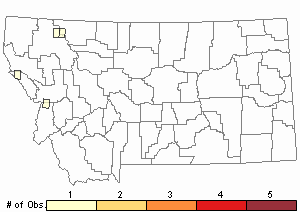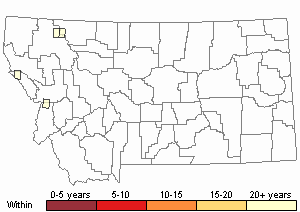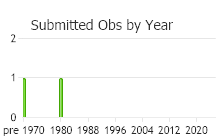View in other NatureServe Network Field Guides
NatureServe
Montana
Utah
Wyoming
Idaho
Wisconsin
British Columbia
South Carolina
Yukon
California
New York
A Dicranum Moss - Dicranum howellii
General Description
Plants: Acrocarpous. Growing in open to crowded clumps of erect shoots, shiny, green or green with yellow tones. Stems 2-8 cm tall; rhizoids pale to russet and thickly covering the stem with woolly matting (FNA 2007).
Leaves: Ranging from curved and pointing to one side of the stem to straight and upright, occasionally curled and twisted a little, lance-shaped and cupped below, keeled and also and tube-like from the infolded margins above, and folded longitudinally (FNA 2007), not wavy (Lawton 1971), the leaf tip acute, 5-12 mm in length, 0.8-1.5 mm in width; margins coarsely saw-toothed above, smooth below; costa nearly reaching or slightly surpassing the leaf tip, with 2 (seldom 4) dorsal dentate crests running from ca mid-leaf almost to the leaf tip or seldom fairly smooth (FNA 2007).
Leaf Cells: Lamina 1 cell-layer thick, the cells smooth, the cell walls between cells lacking bulges; distal laminal cells wavy and porose; lower laminal cells quadrangular and very thin, porose, longer than the cells above; alar cells distinct, inflated, the alar region occasionally reaching the costa and 2 cell-layers thick; costa in X-section with weak ventral and dorsal stereid bands, guide cells in 1 row, the cells of the ventral epidermal layer not distinct and those of the dorsal layer discontinuous from a few large cells of the dorsal crest inserted amongst them (FNA 2007).
Phenology
Fruit ripens in spring (FNA 2007).
Diagnostic Characteristics
Although characteristics of the perichaetial leaves are the most significant in distinguishing this species from D. scoparium, the following vegetative features are also helpful. D. scoparium has leaves that are sometimes shiny (other times dull) and shorter (5-8.5 mm) rather than always shiny and longer (8-10 mm), shorter upper laminal cells, and typically 4, seldom 2, dorsal saw-toothed crests on the costa rather than mostly 2, seldom 4, as in D. howellii (FNA 2007).
Range Comments
A northwestern North American endemic found in AK, BC s to CA, ID and MT (FNA 2007). Known in Montana from Flathead, Glacier, Mineral, and Ravalli Counties (Elliott 2016).
Observations in Montana Natural Heritage Program Database
Number of Observations: 6
(Click on the following maps and charts to see full sized version)
Map Help and Descriptions
Relative Density

Recency



 (Observations spanning multiple months or years are excluded from time charts)
(Observations spanning multiple months or years are excluded from time charts)
Habitat
Decaying wood, humus, soil, occasionally bogs. Elevation: 70-1971 feet (FNA 2007).
Reproductive Characteristics
Dioicous, sometimes small males growing on female plant rhizoids, or female and male plants similar in size and mingling or occurring in somewhat separate clumps. Inner perichaetial bracts only partially enveloping the stem, slowly tapering to form an acumen. Seta single or occasionally 2 in a perichaetium, 15-40 mm tall, russet or yellow. Capsule bowed, tilted to level, sometimes longitudinally lined when dry, 2-3.8 mm in length; peristome of 16 teeth, separated ca halfway down into 2 lobes (seldom 3), russet, with papillae above. Calyptra hood-like, hairless, sheltering much of the capsule, falling away easily (FNA 2007).
Stewardship Responsibility
References
- Literature Cited AboveLegend:
 View Online Publication
View Online Publication Elliott, J.C. and A.K. Pipp. 2018. A Checklist of Montana Mosses (1880-2018). Updated 3 January, 2020. Montana Natural Heritage Program, Helena, Montana. 73 pp.
Elliott, J.C. and A.K. Pipp. 2018. A Checklist of Montana Mosses (1880-2018). Updated 3 January, 2020. Montana Natural Heritage Program, Helena, Montana. 73 pp. Flora of North America Editorial Committee, eds. 2007. Flora of North America North of Mexico. Volume 27. Bryophytes: Mosses, Part 1. Oxford University Press, Inc., NY. xxi + 713 pp.
Flora of North America Editorial Committee, eds. 2007. Flora of North America North of Mexico. Volume 27. Bryophytes: Mosses, Part 1. Oxford University Press, Inc., NY. xxi + 713 pp. Lawton, E. 1971. Moss Flora of the Pacific Northwest. Hattori Botanical Laboratory. Japan: Yamabuki-cho, Shinjuku-ku, Tokyo. 362 pages plus appendices.
Lawton, E. 1971. Moss Flora of the Pacific Northwest. Hattori Botanical Laboratory. Japan: Yamabuki-cho, Shinjuku-ku, Tokyo. 362 pages plus appendices.
- Additional ReferencesLegend:
 View Online Publication
View Online Publication
Do you know of a citation we're missing? Elliot, J. C. 1993. Second checklist of Montana mosses. Unpublished report. U.S. Forest Service, Region 1. Missoula, MT. 45 pp.
Elliot, J. C. 1993. Second checklist of Montana mosses. Unpublished report. U.S. Forest Service, Region 1. Missoula, MT. 45 pp. Lawton, E. 1971. Keys for the Identification of the Mosses on the Pacific Northwest. Reprinted from 'Moss Flora of the Pacific Northwest'. Published as Supplement No. 2 of the Journal of the Hattori Botanical Laboratory. Nichinan, Miyazaki, Japan. 66 pp.
Lawton, E. 1971. Keys for the Identification of the Mosses on the Pacific Northwest. Reprinted from 'Moss Flora of the Pacific Northwest'. Published as Supplement No. 2 of the Journal of the Hattori Botanical Laboratory. Nichinan, Miyazaki, Japan. 66 pp. Malcolm, B., N. Malcolm, J. Shevock, and D. Norris. 2009. California Mosses. Nelson, New Zealand: Micro-Optics Press. 430 pp.
Malcolm, B., N. Malcolm, J. Shevock, and D. Norris. 2009. California Mosses. Nelson, New Zealand: Micro-Optics Press. 430 pp.
- Web Search Engines for Articles on "A Dicranum Moss"





